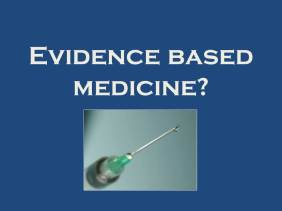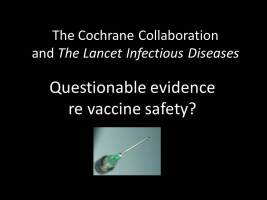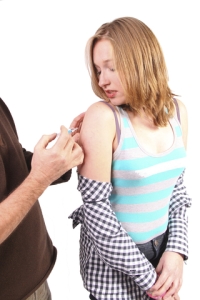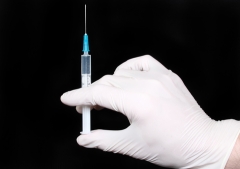Internationally, The Cochrane Collaboration undertakes systematic reviews of primary research in human health care and health policy, including reviews of the effectiveness of vaccine products.

The Cochrane Collaboration declares its mission “is to promote evidence-informed health decision-making by producing high-quality, relevant, accessible systematic reviews and other synthesised research evidence”.
See below my recent letter to Professor Peter Gøtzsche, co-founder of The Cochrane Collaboration and Director of the Nordic Cochrane Centre, challenging a systematic review prepared by members of the Cochrane Vaccines Field, i.e. Adverse events after immunisation with aluminium-containing DTP vaccines: systematic review of the evidence. I suggest this review has facilitated poorly evidenced acceptance of the safety of aluminium-adjuvanted vaccines.
_____________________
8 July 2014
Professor Gøtzsche
I write to you to challenge a systematic review prepared by members of the Cochrane Vaccines Field[1] , i.e. Adverse events after immunisation with aluminium-containing DTP vaccines: systematic review of the evidence.[2]
I request that The Cochrane Collaboration[3] take urgent action to re-evaluate this review prepared by members of the Cochrane Vaccines Field.
I suggest this review has facilitated poorly evidenced acceptance of the safety of aluminium-adjuvanted vaccines. As a consequence, an increasing number of aluminium-adjuvanted vaccines are being added to vaccination schedules around the world e.g. multiple doses of diphtheria, tetanus and pertussis vaccines, and multiple doses of human papillomavirus (HPV) vaccine, amongst others. The meningococcal B vaccine is the latest to be promoted.[4] The long-term cumulative effects of the ever-growing list of vaccine products are unknown.
The systematic review, co-authored by Tom Jefferson, Melanie Rudin and Carlo Di Pietrantonj, and published in The Lancet Infectious Diseases in 2004 (behind the pay-wall), concludes in the abstract: “We found no evidence that aluminium salts in vaccines cause any serious or long-lasting adverse events. Despite a lack of good-quality evidence we do not recommend that any further research on this topic is undertaken.” (My emphasis.)
More detail on this conclusion is provided in the discussion, i.e. “Our meta-analysis of the outcome data has enabled us to reach firm conclusions on the limited amount of comparative data available. Since there was no association with severe adverse events in young children or with induration in older children, we believe any association with chronic outcomes to be unlikely. The results of our review should be interpreted within the limited quantity and quality of available evidence. Within these limits, we found no evidence that aluminium salts cause any serious or long-lasting adverse events. We found no comparative evidence assessing any possible associations between exposure to aluminium adjuvants and rare and hitherto little known outcomes such as macrophagic myofasciitis.” (My emphasis.)
In their review Jefferson et al admit that: “Overall, the methodological quality of included studies was low.” And yet “despite a lack of good-quality evidence” Jefferson et al advise “we do not recommend that any further research on this topic is undertaken”.
This recommendation is bizarre, particularly as in an interview with The Telegraph in 2002 titled “Vaccines expert warns studies are useless”[5], Tom Jefferson candidly stated: “Most safety studies on childhood vaccines have not been conducted thoroughly enough to tell whether the jabs cause side effects”. Dr Jefferson said: “There is some good research, but it is overwhelmed by the bad. The public has been let down because the proper studies have not been done.” Perhaps reluctant to “anger public health officials in Britain and elsewhere, who fear that any discussion will undermine parents’ confidence in national vaccination programmes”, The Telegraph article reports Dr Jefferson “emphasised that there was no evidence to suggest that any vaccine now in use was dangerous” but said “there was a “dearth” of sound studies on the risks and benefits” and “as a result, the information available on the safety of vaccines that are routinely given to babies and toddlers was “simply inadequate”.” It was reported Dr Jefferson “was especially concerned…because future vaccination programmes were likely to involve giving children “five, six, even seven vaccines all at once”.” Which of course is exactly what happens now, see for example vaccination schedules in the US[6], the UK[7] and Australia[8] .
Given Dr Jefferson’s apparent appreciation of the ‘dearth’ of sound studies on the risks and benefits of vaccine products, and his concern about future vaccination programmes including “five, six, even seven vaccines all at once”, it is unaccountable that he and his colleagues could conclude in their strategic review “we do not recommend that any further research on this topic is undertaken”.
From my layperson’s perspective, Jefferson et al’s ‘systematic review’ is an example of ‘garbage in, garbage out’.
It appears to me this systematic review was biased from the outset, and that the goal was to defend the use of aluminium adjuvants, i.e.: “Assessment of the safety of aluminium in vaccines is important because replacement of aluminium compounds in currently licensed vaccines would necessitate the introduction of a completely new compound that would have to be investigated before licensing. No obvious candidates to replace aluminium are available, so withdrawal for safety reasons would severely affect the immunogenicity and protective effect of some currently licensed vaccines and threaten immunisation programmes worldwide.” (My emphasis.)
This Cochrane Vaccines Field review plays into the hands of vaccine manufacturers who are keen to develop a mass market for lucrative vaccine products. A World Health Organisation presentation acknowledges that vaccines are “becoming an engine for the pharmaceutical industry”, creating a global market with a “spectacular growth rate”, growing in value from US$5 billion in 2000 to almost US$24 billion in 2013, and projected to rise to US$100 billion by 2025.[9]
In 2009, Associated Press reported: “Vaccines now are viewed as a crucial path to growth, as drug companies look for ways to offset a slowing of prescription-medicine sales amid intensifying generic competition and government pressure to restrain prices under the federal health-care overhaul”.[10] An article published in New Scientist in late 2011 says: “No longer the unprofitable runt of the pharmaceutical family, vaccines are fast becoming the industry’s breadwinner…While the rest of the pharmaceutical sector struggles to keep afloat as expiring patents send profits plummeting, the vaccine industry has become remarkably buoyant.”[11] In 2012, FierceVaccines noted: “Thanks in part to the adult influenza market and vaccines such as Gardasil and Prevnar, the global vaccines market has enjoyed a decidedly solid boost in revenue.”[12]
Vaccine products of dubious value are being pressed upon the community. For instance, Merck and GlaxoSmithKline are pushing universal vaccination with the questionable human papillomavirus vaccines Gardasil and Cervarix, despite the fact the co-inventor of the technology enabling the HPV vaccines, Professor Ian Frazer, has acknowledged that the risk of cancer associated with the HPV virus is very low. (Refer to my webpage on HPV vaccination[13] for more background.)
Similarly multiple revaccinations with the diphtheria, tetanus and acellular pertussis vaccines are also being ‘recommended’, which means they are effectively mandated for children.[14] For example, according to the US vaccination schedule, as well as the primary vaccination series at two, four and six months, this vaccination combination is ‘recommended’ again between 15-18 months, a fifth shot between 4-6 years, and another shot between 11-12 years.[15]
In regards to pertussis/whooping cough outbreaks, in March 2012, the UNSW Newsroom reported: “Australia’s prolonged whooping cough epidemic has entered a disturbing new phase, with a study showing a new strain or genotype capable of evading the vaccine may be responsible for the sharp rise in the number of cases…The new genotype also has been detected in other countries, suggesting it has the potential to spark epidemics elsewhere and should be closely monitored…”[16]
One of the researchers, A/Professor Ruiting Lan said: “The vaccine is still the best way to reduce the transmission of the disease and reduce cases, but it appears to be less effective against the new strain and immunity wanes more rapidly. We need to look at changes to the vaccine itself or increase the number of boosters”. (My emphasis.)
I wrote to A/Professor Lan[17], asking him to clarify how increasing the number of ‘boosters’ of the existing vaccine protects against the new strain. Professor Lan did not deign to respond to my enquiry. I subsequently tried to contact his colleague Professor Lyn Gilbert[18] but again received no response.
I also raised the matter with Dr Linjie Zhang[19], an author of the Cochrane Review: Acellular vaccines for preventing whooping cough in children.[20] Dr Zhang also failed to respond, yet another example of the lack of accountability of the academic community to the concerns of citizens re the promotion of vaccine products.
In the US[21], the UK[22] and Australia[23] pregnant women are being urged to be vaccinated with a dose of diphtheria, tetanus and pertussis vaccine, even though it is admitted that “specific safety data are limited”.[24] Other close contacts of young infants are also encouraged to be vaccinated, i.e. the ‘cocoon strategy’.[25] What evidence is there to support this strategy? Certainly repeated ‘boosters’ throughout life with these vaccines must be a profit boost for vaccine manufacturers.
Meanwhile others are raising questions about the safety of aluminium adjuvants in vaccine products, e.g. Professor Christopher Exley[26], Dr Lucija Tomljenovic and Professor Chris Shaw.[27]
I suggest it is time to critically consider the ever-growing list of vaccine products and revaccinations being added to vaccine schedules.
Is it possible an over-use of vaccine products may have long-term repercussions similar to the over-use of antibiotics?[28] Who can we rely upon to objectively review the burgeoning global vaccine product market? Certainly I have no confidence in the international ‘vaccination claque’ which pushes an ever-growing list of vaccine products.[29] As I outline in my recent letter to Professor Warwick Anderson, CEO of Australia’s National Health and Medical Research Council (NHMRC), the ethical spotlight needs to be shone on the way vaccination policy and practice is being implemented.[30] In my letter I provide examples of the lack of transparency and accountability in the vaccination bureaucracy, including the potential conflicts of interest and lack of disclosure by people involved in vaccination policy in Australia. My arguments are also relevant internationally.
Professor Gøtzsche, The Cochrane Collaboration’s stated mission is “to promote evidence-informed health decision-making by producing high-quality, relevant, accessible systematic reviews and other synthesised research evidence”.[31] The Cochrane Collaboration has a reputation to maintain and it doesn’t always get it right the first time, as we know from Hayashi/Tamiflu.[32] [33] I suggest The Cochrane Collaboration cast a more critical eye on the growing list of lucrative vaccine products.
I request your urgent attention to the matters I have raised.
Sincerely
Elizabeth Hart
https://over-vaccination.net/
*Please note, in addition to the cc list below, this letter will be circulated to other parties, and has also been published on my website.
cc:
- Dr Tom Jefferson, Cochrane Vaccines Field
- Mr Mark Wilson, CEO, The Cochrane Collaboration
- Professor Paul Glasziou, Bond University
- Professor Chris Del Mar, Bond University
- Mr Ray Moynihan, Bond University
- A/Professor Peter Doshi, University of Maryland
- Dr Fiona Godlee, British Medical Journal
- Professor Peter Collignon, Australian National University
- Professor Christopher Exley, Keele University
- Professor Chris Shaw, University of British Columbia
- Dr L Tomljenovic, University of British Columbia
- Professor Warwick Anderson, NHMRC
- Professor Ian Olver, NHMRC Australian Health Ethics Committee
- Professor Ian Frazer, University of Queensland
- A/Professor Ruiting Lan, University of New South Wales
- Professor Lyn Gilbert, University of Sydney
- Dr Linjie Zhang, Federal University of Rio Grande
- Professor Ronald Schultz, Vaccination Guidelines Group, World Small Animal Veterinary Association
- Professor Michael Day, Vaccination Guidelines Group, World Small Animal Veterinary Association
- Professor Brian Martin, University of Wollongong
- Ms Bea Mies, Independent Vaccine Investigator
- Ms Monika Peichl, Independent Vaccine Investigator
References: (All links accessible as at 7 July 2014. It may be necessary to copy and paste long links into a web browser.)
[1] Cochrane Vaccines Field: “It is the intention of the Cochrane Vaccines Field to contribute to a greater global understanding of vaccine quality by facilitating the identification, assembling, analysis, synthesis, dissemination and updating of information on the effects of vaccines from single studies into reviews.”: http://vaccinesfield.cochrane.org/aims-and-activities
[2] Jefferson T, Rudin M, Di Pietrantoni C. Adverse events after immunisation with aluminium-containing DTP vaccines: systematic review of the evidence. Lancet Infect Dis. 2004 Feb; 4(2):84-90: http://www.ncbi.nlm.nih.gov/pubmed/14871632 This review is also listed in the Cochrane Vaccines Field Bibliography: http://vaccinesfield.cochrane.org/bibliography-2003
[3] The Cochrane Collaboration: “Cochrane is a global independent network of health practitioners, researchers, patient advocates and others, responding to the challenge of making the vast amounts of evidence generated through research useful for informing decisions about health. We are a not-for-profit organisation with collaborators from over 120 countries working together to produce credible, accessible health information that is free from commercial sponsorship and other conflicts of interest.”http://www.cochrane.org/about-us
[4] The Joint Committee on Vaccination and Immunisation originally rejected the Bexsero Meningitis B Vaccine see for example: Meningitis B vaccine rejected by UK – Joint Committee on Vaccination and Immunisation says there is not enough evidence to justify routine jabs with Bexsero, The Guardian, 24 July 2013: http://www.theguardian.com/society/2013/jul/24/meningitis-b-vaccine-rejected-uk This decision was subsequently overturned after a “determined campaign by doctors, health charities, a public petition and a wave of letters to Health Secretary Jeremy Hunt”: Babies to get jab on NHS against lethal meningitis B – A life-saving vaccine against deadly meningitis B will be introduced on the NHS for all babies from two months old in a dramatic U-turn announced yesterday, Express, 22 March 2014: http://www.express.co.uk/life-style/health/466236/Jeremy-Hunt-changes-NHS-baby-vaccine-policy-after-huge-letter-campaign Also refer to the JCVI position statement on use of Bexsero meningococcal B vaccine in the UK. March 2014: https://www.gov.uk/government/uploads/system/uploads/attachment_data/file/294245/JCVI_Statement_on_MenB.pdf
[5] Lorraine Fraser. Vaccines expert warns studies are useless. The Telegraph, 27 October 2002: http://www.telegraph.co.uk/news/uknews/1411417/Vaccines-expert-warns-studies-are-useless.html
[6] Centers for Disease Control and Prevention. Immunization Schedules. Birth-18 Years & “Catch-up” Immunization Schedules, United States 2014: http://www.cdc.gov/vaccines/schedules/hcp/child-adolescent.html
[7] The NHS vaccination schedule: http://www.nhs.uk/Conditions/vaccinations/Pages/vaccination-schedule-age-checklist.aspx
[8] National Immunisation Program Schedule from 1 July 2013: http://www.immunise.health.gov.au/internet/immunise/publishing.nsf/Content/nips-ctn
[9] Miloud Kaddar, Senior Adviser, Health Economist, WHO, IVB, Geneva. Gobal Vaccine Market Features and Trends: http://who.int/influenza_vaccines_plan/resources/session_10_kaddar.pdf (Powerpoint slides 5 and 6.)
[10] Linda A Johnson. Vaccines become drugmakers’ profit boosters. Pharmaceutical companies drawn to development of vaccines for variety of diseases. The Columbus Dispatch, 30 November 2009: http://www.dispatch.com/content/stories/business/2009/11/30/vaccine_revolution.ART_ART_11-30-09_A10_7NFQQE7.html
[11] Deborah MacKenzie. Vaccines enjoy a healthy return. NewScientist, 28 September 2011: http://www.newscientist.com/article/dn20877-vaccines-enjoy-a-healthy-return.html#.U7Np2vmSz-s
[12] Alison Bryant. 20 Top-selling Vaccines – H1 2012. FierceVaccines, 25 September 2012: http://www.fiercevaccines.com/special-report/20-top-selling-vaccines/2012-09-25
[13] Human papillomavirus (HPV) vaccination: https://over-vaccination.net/questionable-vaccines/hpv-vax/
[14] I suggest vaccination ‘recommendations’ are effectively vaccination mandates. For example, in the US the Advisory Committee on Immunization Practices (ACIP) makes vaccination ‘recommendations’: http://www.cdc.gov/vaccines/schedules/downloads/child/0-18yrs-child-combined-schedule.pdf which translate into vaccination ‘requirements’: http://www2a.cdc.gov/nip/schoolsurv/schimmrqmt.asp In Australia, parents of children have to “meet certain immunisation requirements” to obtain “immunisation related payments for parents”: http://www.immunise.health.gov.au/internet/immunise/publishing.nsf/Content/related-payments
[15] Centers for Disease Control and Prevention. Immunization Schedules. Birth-18 Years & “Catch-up” Immunization Schedules, United States 2014: http://www.cdc.gov/vaccines/schedules/hcp/child-adolescent.html
[16] UNSW Australia Newsroom. Sharp rise in cases of new strain of whooping cough, 21 March 2012: https://newsroom.unsw.edu.au/news/health/sharp-rise-cases-new-strain-whooping-cough
[17] Email to Associate Professor Ruiting Lan, 4 December 2012: http://users.on.net/~peter.hart/Enquiry_re_JID_Report_pertussis_epidemic.pdf
[18] Email to Professor Lyn Gilbert, 11 December 2012: http://users.on.net/~peter.hart/Whooping_cough_enquiry.pdf
[19] Email to Dr Linjie Zhang, 11 December 2012: http://users.on.net/~peter.hart/Enquiry_re_pertussis_vaccination_Cochrane.pdf
[20] Zhang L, Prietsch SOM, Axelsson I, Halperin SA. Acellular vaccines for preventing whooping cough in children. Cochrane Database of Systematic Reviews 2012, Issue 3. Art. No.: CD001478. DOI: 10.1002/14651858.CD001478.pub5. http://onlinelibrary.wiley.com/doi/10.1002/14651858.CD001478.pub5/abstract
[21] Centers for Disease Control and Prevention. Tdap Vaccine – What You Need to Know. “Pregnant women should get a dose of Tdap during every pregnancy, to protect the newborn from pertussis.”: http://www.cdc.gov/vaccines/hcp/vis/vis-statements/tdap.pdf
[22] Whooping cough vaccination in pregnancy. NHS Choices. “Pregnant women can safely help protect their babies by getting vaccinated against whooping cough (pertussis) when they are 28-38 weeks pregnant.” http://www.nhs.uk/conditions/pregnancy-and-baby/pages/whooping-cough-vaccination-pregnant.aspx#safe
[23]4.12 Pertussis. The Australian Immunisation Handbook 10th Edition 2013. “dTpa vaccine is recommended as a single dose, given either during pre-pregnancy planning, or as soon as possible after delivery of the infant (preferably before hospital discharge). Alternatively, dTpa can be given to women during the third trimester of pregnancy…”: http://www.immunise.health.gov.au/internet/immunise/publishing.nsf/Content/handbook10-4-12
[24] 4.12.8 Pregnancy and breastfeeding (re pertussis vaccination). The Australian Immunisation Handbook 10th Edition 2013. While attempting to justify vaccination of pregnant women, this section also acknowledges “…specific safety data are limited”: http://www.immunise.health.gov.au/internet/immunise/publishing.nsf/Content/handbook10-4-12
[25] 4.12.7 Recommendations (re pertussis vaccination). Persons in contact with infants and others at increased risk from pertussis: http://www.immunise.health.gov.au/internet/immunise/publishing.nsf/Content/handbook10-4-12
[26] See for example: Exley C et al. A role for the body burden of aluminium in vaccine-associated macrophagic myofasciitis and chronic fatigue syndrome. Medical Hypotheses. Vol. 72, Iss. 2, Feb. 2009, pp 135-139.
[27] See for example: Tomljenovic L and Shaw CA. Aluminium Vaccine Adjuvants: Are they Safe? Current Medicinal Chemistry, 2011, 18, pp 2630-2637; and Shaw CA and Tomljenovic L. Aluminium in the central nervous system (CNS): toxicity in humans and animals, vaccine adjuvants, and autoimmunity. Immunologic Research, 2013, July 56 (2-3) pp 304-316.
[28] In regards to overuse of antibiotics see for example: PM’s plan on antibiotics not urgent enough, reports says, BBC News Health, 7 July 2014: http://www.bbc.com/news/health-28165152 This is a topic to watch very carefully, particularly in regards to vested interests, as apparently the solution to overuse of antibiotics is…more antibiotics, e.g. “What this demands, according to academic and industry experts, is a new business model that rewards drug firms for developing new antibiotics even if they are rarely used.” How to fix a broken market in antibiotics, Reuters, 6 July 2014: http://in.reuters.com/article/2014/07/06/uk-health-antibiotics-idINKBN0FB0AE20140706 Also see: UPDATE1 – Cameron enlists ex-Goldman economist in global superbug fight, Reuters, 2 July 2014: http://www.reuters.com/article/2014/07/02/health-antibiotics-idUSL6N0PD25O20140702
[29] I suggest the ‘vaccination claque’ consists of the network of vaccine manufacturers, vaccination committees and groups, academics, bureaucrats, and organisations such as the World Health Organisation, US Centers for Disease Control and Prevention, US National Institutes of Health, the GAVI Alliance, the Bill & Melinda Gates Foundation, National Health and Medical Research Council etc. This is a powerful network and potential conflicts of interest need to be scrutinised.
[30] Letter to Professor Warwick Anderson, CEO, National Health and Medical Research Council (NHMRC), re Vaccination policy and practice in Australia, dated 15 April 2014: http://users.on.net/~peter.hart/Letter_to_Warwick_Anderson_NHMRC_re_MMR_vaccination.pdf
[31] The Cochrane Collaboration – About us – Our Mission: http://www.cochrane.org/about-us
[32] Tom Jefferson. Hayashi’s Problem: Dr Keiji Hayashi’s question re Cochrane’s Tamiflu/Oseltamivir review: “We have some questions on the conclusion in your Oseltamivir review especially about the prevention of complication. You described that “Oseltamivir 150 mg daily prevented lower respiratory tract complications (OR 0.32, 95% CI 0.18 to 0.57).” (in abstract). However, we have found that this conclusion is based on the other review (Kaiser2003) and not on your own data analysis. The authors of the review were four employees of F. Hoffman-La Roche Ltd, one paid consultant to F. Hoffman-La Roche Ltd and Kaiser. We cannot find any raw data about this conclusion from your review. Kaiser’s review included 10 RCTs; two RCTs (Nicholson 2000 and Treanor 2003) were published as articles in the peer-reviewed medical journal (JAMA and Lancet), but other 8 RCTs were proceedings of congress (5 RCTs), abstracts of the congress (one RCT) and meeting (one RCT) and data on file, Hoffmann-La Roche, Inc, Nutley, NJ (one RCT). The lower respiratory tract complication rates of these articles were summarized on table: there was no significant difference between Oseltamivir and placebo, and their Odds Ratio’s (ORs) were 1.81. But ORs of other 8 RCTs were 4.37. We strongly suppose that the reviewer’s conclusion about the complications was mainly determined by these 8 RCTs, we should appraise the 8 trials rigidly. Without this process it’s difficult to conclude that oseltamivir can prevent lower respiratory tract complications.” (Powerpoint slide 12): http://chmg.cochrane.org/sites/chmg.cochrane.org/files/uploads/Jefferson_Hayashi’s%20problem.pdf
[33] Martin Enserink. Armed With New Data, Researchers Again Challenge Effectiveness of Antiflu Drug. ScienceInsider. 9 April 2014: http://news.sciencemag.org/health/2014/04/armed-new-data-researchers-again-challenge-effectiveness-antiflu-drug
 The Institute for the Protection of Natural Health (Institut pour la Protection de la Santé Naturelle), based in Brussels, in conjunction with French oncologist and surgeon Professor Henri Joyeux, has launched a French petition against the HPV vaccines Gardasil and Cervarix.
The Institute for the Protection of Natural Health (Institut pour la Protection de la Santé Naturelle), based in Brussels, in conjunction with French oncologist and surgeon Professor Henri Joyeux, has launched a French petition against the HPV vaccines Gardasil and Cervarix.
















You must be logged in to post a comment.